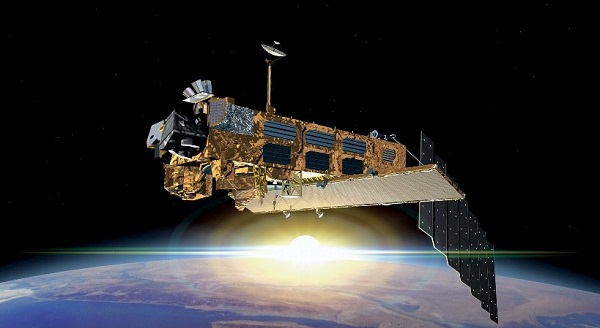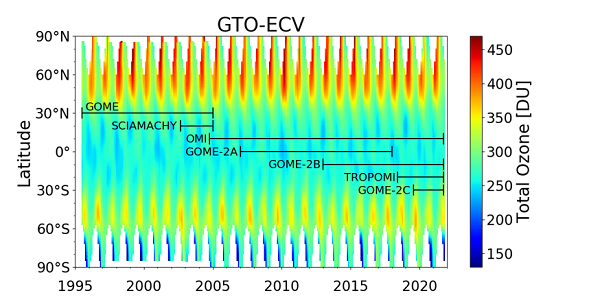- Learn & Discover
- Satellites track the health of...
Satellites track the health of the ozone layer
16 Sep 2022
ESA’s Earth observation activities are contributing to international efforts to monitor and preserve the layer of stratospheric ozone that blankets the planet.
The ozone layer is the world’s natural sunshield, protecting life on Earth from the harmful effects of excessive ultraviolet radiation.
But in the mid-1970s scientists warned that the release of chemicals called chlorofluorocarbons (CFCs) – which were commonly used in fridges and aerosol cans – could trigger the depletion of stratospheric ozone, with potentially devastating consequences.
By 1985, the presence of an annually occurring ozone hole over Antarctica was confirmed, using ground-based measurements.

Atmospheric researchers have since reported that this breach of the ozone layer is driven in part by the special meteorological conditions over Antarctica, which cause CFCs above the continent to be particularly effective in depleting ozone.
Following the discovery of the Antarctic ozone hole, scientists raised the alarm to the international community, which came together to set out an ambitious set of measures to phase out ozone depleting substances, called the Montreal Protocol.
The protocol – which came into effect in 1989 – was updated in 2016 with the Kigali Amendment to address the emerging threat of new ozone depleting gases.
The adoption of the Montreal Protocol proved to be a crucial turning point, drastically reducing the release of CFCs into the atmosphere.
However, reversing ozone depletion is a slow process and the ozone layer is expected to take several decades to recover.
Revealing the impact of the Montreal Protocol
Early ESA missions that are no longer operational – known as Heritage Missions – were instrumental in tracking the heath of the ozone layer in the decades following the implementation of the Montreal Protocol.
In 1995 ESA launched the second mission of its European Remote Sensing (ERS) programme, called ERS-2. The satellite carried a sensor dedicated to monitoring the composition of the atmosphere, named the Global Ozone Monitoring Experiment (GOME).
This instrument delivered a step change in the monitoring of ozone, providing measurements at higher spectral resolution and over a broader range of wavelengths than was previously possible.
ERS-2 continued to gather data until the end of its mission in 2011.
Following ERS-2, ESA’s Envisat satellite was lofted into orbit in 2002, which collected 10 years of data detailing different aspects of Earth’s environment.
Envisat hosted 10 instruments, three of these – GOMOS, MIPAS and SCIAMACHY – further improved scientists’ understanding of the ozone layer.

ERS-2 and Envisat provided high-quality information on the annual formation and recovery of the Antarctic ozone hole, as well as the health of the ozone layer blanketing the rest of the planet, from the mid-1990s until 2012.
Data from the missions – which are maintained, made accessible, and improved, through the Heritage Space Programme – have proven to be a vital resource, helping the international community to track the impacts of the Montreal Protocol.
ESA’s Climate Change Initiative – coordinated by the agency’s Climate Office in the UK – combines information from ERS-2 and Envisat with data from a number of other Earth observation missions, to create decades-long time series that detail the health of the ozone layer.

This has helped to reveal that the ozone hole is showing early signs of recovery, as well as enabling scientists to explore how the state of the ozone layer influences the climate.
In addition, these data have contributed to the last three editions of the WMO Ozone Assessment Report, which guides policymakers as they work to strengthen the original provisions of the Montreal Protocol.
International missions probe Earth’s sunshield
In addition to ESA missions, several commercial and institutional missions operated by the agency’s international partners are delivering information on ozone in the stratosphere.
Through its Third Party Missions (TPM) programme, ESA is disseminating these data for free to a range of stakeholders for research purposes.
The Japanese Greenhouse Gases Observing SATellite (GOSAT) series, for instance, consists of two innovative satellites that are dedicated to monitoring greenhouse gases in the atmosphere, particularly methane and carbon dioxide.
The first GOSAT mission – which launched in 2009 and remains operational – hosts a gas observation sensor and a cloud and aerosol sensor. In 2018, it was joined in orbit by GOSAT-2, which carries enhanced versions of its predecessor’s instruments.
In addition, the Canadian SciSat-1 mission – which launched in 2003 and remains operational – aims to monitor and analyse the chemical processes that control the distribution of ozone in the upper troposphere and stratosphere.
Another TPM – called Odin – provides observation of stratospheric ozone chemistry, supporting research into aeronomy. The mission launched in 2001 and continues to collect data.
Future missions
In the next decade, a new ESA atmosphere-monitoring mission is set to help scientists study stratospheric ozone.
Due to launch in 2025, the Atmospheric Limb Tracker for Investigation of the Upcoming Stratosphere – or Altius – mission will carry a high-resolution spectral imager, using a limb-sounding technique to deliver profiles of ozone and other trace gases in the atmosphere. The satellite is being developed as part of ESA’s Earth Watch programme.
As the international community advances its efforts to reverse ozone depletion, remote sensing data – from past, present, as well as future missions – will continue to play a crucial role in monitoring the recovery of ozone in the stratosphere.